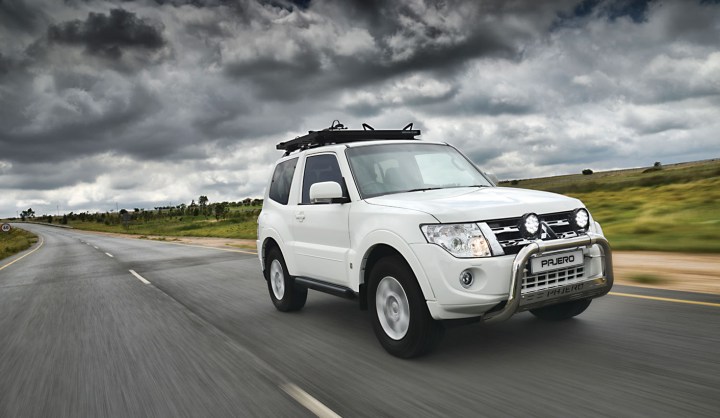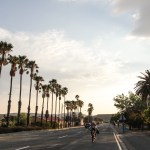Maverick Life
Mitsubishi Pajero 3.3 D-iD SWB: All-terrain terrier

The short-wheelbase Mitsubishi Pajero has been an all-terrain favourite for well over a decade. That’s as much an indication of the nameplate’s established credibility in off-road circles as it is testament to the little all-terrain terrier’s tenacity when the going gets tough. DEON SCHOEMAN drives the latest version on the West Coast – and finds that nothing much has changed.
Mitsubishi’s short-wheelbase Pajero is something of an off-road legend. It’s also a unique offering in a leisure vehicle segment filled with anything from fashionista fun machines to gung-ho go-anywhere 4x4s. You see, the ‘shorty’ links a two-door cabin to a luxurious cabin and pukka all-wheel drive.
The two-door layout can be misleading: it might look more softroader than serious 4×4, but those in the know will instantly recognise the Pajero’s chunky dimensions, and acknowledge that its short overhangs, wide tracks and raised ride height were inspired by functional rather than styling considerations.
In fact, there’s something vaguely canine about the shorty: like a Staffordshire terrier, it manages to look purposeful and pugilistic, as if forever spoiling for a fight. Those who have underestimated its go-anywhere prowess, compared to full-sized 4x4s, have often found themselves humbled.
With such a pedigree, it comes as no surprise that the Pajero SWB is a perennial 4×4 favourite, and that despite its two most obvious handicaps: the lack of rear doors, and an asking price well above what you’d expect to pay for a two-door SUV.
Nor does it have any direct rivals: the only two that come to mind are both far more Spartan in execution and appointment terms. Land Rover’s Defender 90 is basic and utilitarian compared to the Pajero, while the Jeep Wrangler is also more off-road focussed, without the Pajero’s long-distance touring talents.
Mitsubishi this week launched the 2014 version of the Pajero SWB, but those expecting a radical newcomer will be sorely disappointed, while fans and owners of the existing model will breathe a sigh of relief.
In fact, you’d be hard-pressed to tell the difference between the 2014 version and last year’s model: apart from some minor cosmetic embellishments, the two are indistinguishable. The most important addition – a rear diff lock — isn’t even visible.
So, flying to Cape Town for a two-day adventure behind the wheel of the Pajero wasn’t really a case of making a new acquaintance, but rather meeting up with an old friend. And what better (and more beautiful) place to put the chunky 4×4 through its paces than the Sandveld.
If, like me, you don’t know what part of the Western Cape I’m referring to, then here’s where to find it: the Sandveld lies north of the Swartland, with its western boundary defined by the cold Atlantic waters of the West Coast, and the towering peaks of the Cederberg hemming it in to the east.
This is the home of Clanwilliam and its rooibos tea, the orange orchards of Citrusdal, the crayfish of Lamberts Bay, and the forests of the Cederberg. The vistas are vast, the summer sky a pale, bleached blue as the unrelenting sun punches the ambient temperatures deep into the 30s.
While the standard Pajero SWB is almost identical to its predecessor in styling terms, the vehicle we’re driving isn’t. It’s one of 30 limited-edition Pajero Legend models, which adds a host of off-road extras to the already comprehensive package.
Think a dual-battery system, under-bonnet compressor, tyre pressure monitoring, heavy duty seat covers, a roof rack, underbody protection plates, LED spot lights and a bold front nerf bar, and you get the picture.
Mitsubishi says the extras are worth R50k, but it has only added R30k to the asking price of the standard version. In short, it’s a deal sweetener, and one I’m pretty sure will be extended, should the demand warrant it.
Heading north along the N7 past Malmesbury, Moorreesburg and Piketberg, provided ample opportunity to assess the Pajero’s road manners. You’d expect the shorty to suffer from a choppy ride, but the suspension provides enough damping to make even bumpy country roads seem smooth.
There’s plenty of urge, too, thanks to the 3,2-litre turbodiesel engine that has been carried over unchanged form the previous model. It still dishes up a lusty 140kW of power, combined with a fat spread of torque that peaks at 441Nm.
On tar, all that urge is transferred to the road via a five-speed automatic gearbox driving the rear wheels. The gearbox isn’t in the same league as the super-smooth seven, eight (or now, even nine-speed) ‘boxes on offer from rival brands, but it does the job without complaint, and there’s enough torque to prevent hunting between gears on steep inclines, or under load.
Tackle the twists and curves of the Piekenierskloof Pass, and you’re reminded that for all its pep, the Pajero SWB is not a sports car. The steering is slow, and the power assistance blunts feedback, while pushing into a corner too fast will elicit speed-scrubbing understeer.
To its credit, the shorty handles changes of direction well, with no sign of lolling body roll, and a nicely planted stance – even when shod with off-road tyres. Also, the brakes deliver reassuring bite when required.
The drive from Cape Town also served as a good opportunity to assess one of the Pajero SWB’s other highlights: its interior appointments. And yes, it is indeed comprehensively kitted out, with the kind of features list you’d expect of a luxury limo.
The front seats are nicely sculpted, and offer heating for those cold winter starts. A decent sound system, USB and Bluetooth connectivity, a multifunction steering wheel, cruise control, a rear reverse camera integrated into the rear-view mirror, and park distance control are among the highlights. You also get six airbags, stability and traction control, and ABS brakes.
But it’s not all good news. There is the inconvenience of having only two doors, making access to the rear bench seat awkward at best. Once seated, rear occupants will find legroom compromised. And the boot is good for little more than a couple of duffel bags and a lunch box.
This then is really a two-seater 4×4, ideal for single adventurers, childless couples or empty-nesters who can fold flat the rear seats and use the extra space for important necessities – a large cooler box, for instance.
At Sybrie de Beer’s Boegoeberg 4×4 route (www.boegoeberg4x4.co.za), which is tucked away in the mountains between Graafwater and Clanwilliam, we get to find out whether the Pajero SWB still lives up to its hard-core off-road reputation. The route winds its way along the contours of sandstone cliffs, up rough and rocky inclines, and even the deep, loose sand of the occasional dry river run.
Engage low range 4×4, lock the diff, and very little will stop the Pajero: driver skill an experience becomes the limiting factor. The shorty has the urge, the traction and the compact dimensions to weave its way through the most treacherous of routes. The turbodiesel’s tractability is another boon, allowing one to gingerly crawl along when required. And all the while, the air-con keeps the cabin (and tempers) cool.
It’s dark by the time we emerge from the mountains and let the Pajero run us down to the sea at Lamberts Bay, a fishing village with little in the way of quaintness, and a large fish factory dominating the beachfront.
But only a few kilometres out of town, Muisbosskerm serves up West Coast seafood at its honest, freshest best: platters of whole snoek and kabeljou, golden strips of tender calamari, crayfish halves grilled to perfection on beds of red-hot coals.
There’s local wine to wash it all down with – rich Swartland reds, mellow Chenin Blancs and steely Sauvignons. Believe me, it’s worth the trip just for a dinner at this place, with the Atlantic swell gently spilling onto the shore just metres away, and the stars as bright as jewels.
An early start on day two gets us to a sea of another kind in less than 15 minutes. The signpost simply reads ‘The Dunes’ (www.dunes.co.za). And dunes is what you get: a sea of dunes, stretching as far as the eye can see.
Oom Smaljoos Engelbrecht is our guide – an octogenarian with the sharp blue eyes of a teenager, a sense of humour drier than the sand we’re driving on, and a beach buggy that’s little more than a rusty frame, a pair of seats and a vintage VW engine.
We follow him as the buggy skips over the sand with light-footed ease. Any concerns I may have had that the Pajero won’t be able to keep up are soon dispelled – the shorty makes it look very easy.
Again, it’s the combination of the turbo diesel engine’s low-down grunt, and the way the gearbox manages to find the best effective ratio, that makes crossing the dunes child’s play. Sitting tall ensures decent all-round vision, and there’s always enough urge in reserve to get you out of a tight spot.
Of course, the wieldier dimensions of the short-wheel base also assist in manoeuvrability, especially when you find yourself having to execute a tight turn in one of the sand bowls without stopping – and running the risk getting stuck. And since the shorty is also lighter than a full-sized Pajero, it zooms over the dunes with real ease.
By the time an increasingly merciless sun turns the light welding torch bright, burning away the shadows and leaving the landscape seemingly flat and featureless, our time has run out. It’s time to head back to Cape Town and a flight home.
Thanks to the Pajero SWB, we’ve enjoyed a tantalising glimpse of what the Sandveld region can offer – from Boegoeberg’s spectacular sandstone vistas, deep kloofs and challenging rock trails to the shifting sands of The Dunes – plus all the landscapes in between.
Experiences like these vindicate owning a vehicle like the Pajero – a SUV with real 4×4 capability that’s still comfortable over the extended on-road distances you’ll typically need to travel to get to the scenic stuff.
The short-wheelbase version trades off the convenience of four doors and a bigger boot against enhanced all-terrain capability. It also happens to look more composed, and more tenacious, than its larger, full-sized Pajero stablemate.
At R549 000 (R579 000 if you opt for the added-value Legend package) it’s not a cheap SUV, but the Pajero SWB’s ability to offer both luxury, long-distance cruising and real go-anywhere talent has been attracting a strong following for years – and the 2014 model will be no different.
The legend lives on. DM
|
Mitsubishi Pajero 3.2 SWB Legend
|

















 Become an Insider
Become an Insider